Why do spider mites appear on indoor plants?
If your indoor flowers are infested with this dangerous pest, you will probably be interested in knowing how to get rid of spider mites.
Types of spider mites
The most common types of spider mites are the Common spider mite, Red spider mite, Red-legged spider mite, Atlantic spider mite, Savzdarga spider mite.
These pests are so small that sometimes they are not noticed at all and no timely control measures are taken, which leads to significant damage to indoor plants and, over time, to their death.
Mites reach only one millimeter in length. Body color is usually pale yellow or pinkish red, depending on the time of year.
Ticks live in their interwoven webs in entire colonies, which can contain hundreds of individuals. At the initial stage of the lesion, they attach to the underside of the leaf. They reproduce very quickly, since they already become adults on the tenth – twentieth day after laying the egg.
How to determine in time that a plant is affected by a mite
Another not pleasant fact is that the mites easily and quite quickly (with favorable conditions) move from one plant to another, capturing ever larger territories.
Causes of spider mites
Most often, mites become active in winter period time when central heating is on and the air in the apartments becomes dry. Plants that are located near heating sources, that are rarely watered and not sprayed, may well be affected by spider mites. Sometimes an already infected plant can be brought home by purchasing it in a store. As mentioned above, this pest is practically invisible, and therefore, at first glance, it can be difficult to immediately determine whether the plant is affected or not. 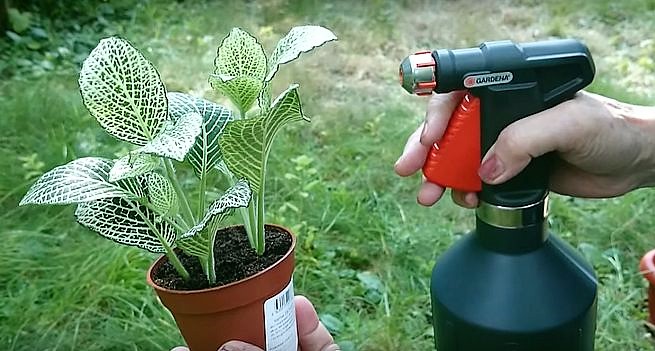
Preventive measures
Spider mites do not like high air humidity, frequent ventilation and drafts, as well as direct sunlight. Therefore, for the purpose of prevention, spray indoor flowers more often with a fine dispersion sprayer, water them on time, preventing the soil from drying out. You can place a humidifier near the plant. This is especially appropriate in winter time when plants stand on window sills, under which heating radiators and radiators are located. Wipe the leaves from dust with a damp cloth, possibly using laundry or tar soap. As a preventive measure, it is good to give your indoor plants a two-minute lighting session under an ultraviolet lamp, at least once a week. Inspect your flowers often and at the first sign of a pest, isolate it from others so as not to infect your entire home collection with mites. Be careful when bringing a new plant into your home. Place him separately for a while, in quarantine. It is advisable to heat purchased soil or mulching material in the oven or microwave before use.
All these measures are certainly good and useful, but if spider mites have settled on your plants, then you need to fight them more thoroughly.
Ways to combat ticks
It is difficult to completely and permanently remove spider mites. Since its eggs can survive for many years, under the first favorable conditions, the cycle of destruction resumes again. Sometimes even thorough treatment of all plants with appropriate preparations does not guarantee that there will be no more ticks in your home.
When starting to process your plants, wrap the pot in a cellophane bag and tie it around the trunk with thread. This is done so that the soil does not wash out or wake up. Under the stream running water Using a shower head, rinse the affected plant thoroughly.
IMPORTANT! A plant such as Uzambara Saintpaulia or, as it is popularly called, violet, does not tolerate moisture in the leaves. They should be cleaned with a dry brush.
After thorough washing, the entire plant is covered with a transparent bag and placed in a shaded place (it is important that open sunlight does not reach it and the plant does not get burned). After staying in such a greenhouse for several days, preferably a week, adult ticks die, which cannot be said about eggs. They must be combated with special chemicals.
Wash the window sill or the place where the flowers stood using soap solution. You can walk over the surface with a cloth soaked in rubbing alcohol. 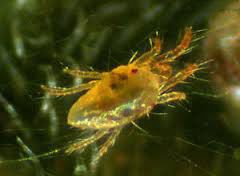
Chemicals to combat spider mites
IN lately industry began to produce special chemicals - acaricides and insectoacaricides.
Popular among them are such drugs as: Akarin (agravertin), Apollo, Envidor, Borneo, Floromite, Omite, Sunmite, Vertimek, Kleschevit, Akarin, Agravertin and many others.
IMPORTANT! All chemicals harmful to human health and domestic animals.
To prevent ticks from developing protective immunity, you should alternate the use of different drugs.
IMPORTANT! When treating plants with serious chemicals, it is necessary to wear protective gloves and a mask, and only in the open space of a yard or street. In extreme cases, spray the plants in the bathroom, followed by ventilation of the room.
It is advisable to carry out processing in dry, windless, warm weather. After spraying the product, leave the plants outdoors for a while until they are sufficiently dry. From time to time it is necessary to repeat the chemical treatment. The time interval between them depends on the air temperature. If the temperature is plus twenty degrees, three treatments should be done with an interval of nine to ten days. If the air temperature is thirty degrees or higher, it must be treated three to four times with an interval of three days.
Safe means
You can try to fight spider mites with safer folk remedies. Of these, the following have worked well: cyclamen root, garlic, dandelion, chamomile, horseradish, tobacco, horse sorrel.
A decoction is prepared from all these plants, which is used to treat affected indoor flowers.
Cyclamen
A decoction of its root is used. The crushed tubers should be boiled for half an hour. The cooled solution is filtered and sprayed on the plants. After a week, the procedure can be repeated.
Dandelion
An infusion of dandelion roots is prepared in much the same way. Take thirty grams of crushed roots per liter of water. The infusion is allowed to steep for some time before using it.
Garlic
Two hundred grams of peeled and chopped garlic are poured with a liter of water and left for a week. To treat plants, six grams of the resulting infusion is mixed with a liter of water.
IMPORTANT! For people who are especially sensitive to strong odors, this method may not be suitable.
Tobacco
Four hundred grams of dry plant are infused in a bucket of water for 24 hours. Next, the infusion is boiled for two hours, filtered and diluted in ten liters clean water with the addition of fifty grams of household soap.
Horseradish
The roots along with the stems are passed through a meat grinder. A ten-liter bucket is filled with chopped horseradish about one-third and filled to the brim with water. Insist for one hour. Then the strained infusion is slightly diluted with water and sprayed on the affected plants.
Chamomile
It can be used either dried (one kilogram of the plant) or fresh (three kilograms). Fill with a bucket of water, heat to seventy degrees and leave for twelve to sixteen hours. Next, everything is filtered and diluted with water two to three times. In principle, this infusion does not cause burns to plants, so it can be used undiluted. Before spraying, you can add a little grated laundry or liquid soap. This is necessary so that the infusion sticks well to the leaves of the plant and does not roll off in drops.
Horse sorrel
Sorrel roots should be stored in the fall. Three hundred grams of crushed roots are poured into a bucket of hot water and left for three hours. Then they treat it in the same way as with chamomile infusion.
Don't forget that all flowers need to be monitored and cared for. Water them on time, feed them according to the season and spray them with a sprayer more often.
It is believed that cobwebs in the house mean money.
But in some houses there are more than enough cobwebs, but no money is added. Why? The thing is that the spider brings good luck only to those houses where there is a pleasant and warm atmosphere. If there are constant conflicts in the family, then the spider, of course, will not bring harm, but don’t expect manna from heaven to descend on you.
In general, a spider on a web is a good messenger, and under no circumstances should you kill it. If such a neighborhood does not suit you, then just carefully take a stick or paper, place the spider on it and take it outside.
Don’t throw away the cobwebs that remain, they may come in handy. Carefully collect it and put it in a linen bag sewn with your own hands. Always carry it with you - it will be your good luck talisman.
If, while cleaning a room, you come across a cobweb in the corner, then this indicates that a lot has accumulated in the house. negative energy. The spider shows you this place, and in this case you should “clean” your apartment.
The spider, for its ability to weave patterns, was a talisman for housewives. Therefore, if you notice a web under a table, chair, near the stove, sofa and in other similar places, then this spider will help you with your housework. Before starting any business, go to the web (even if there is no spider there) and say the following spell once:
“Just as a spider knows his business, so I will know my business. As he skillfully weaves, so my business will go well. So be it!”
But what to do if you do kill a spider? Put it on a piece of paper, fold it 7 times and bury it in the ground, saying the spell 3 times:
“Woe is not me, there will be no trouble. Illness, go away, bring back happiness.”
On indoor plants is one of the worst living pests. It is a small reddish or brownish spider that prefers to settle on the lower leaves of flowers. It is noteworthy that the development of one generation under favorable temperature conditions is possible every 12 days. After such an insect settles, a small cobweb with tiny pieces of white dust forms in the corners of the leaves. If the pest multiplies excessively, the whole plant can literally be enveloped in such a web.
External signs of the affected plant
Spider mites on indoor plants feed mainly on sap, which they obtain by piercing the leaves. Subsequently, the affected flower becomes covered with small yellow spots and dries out. After the loss large quantity leaves, the plant may even die. Favorite places to live are ficus trees, lemons, palm trees various types, as well as cacti.
Fighting spider mites. Preventive measures

How to get rid of spider mites. Expert advice
Remember: spider mites that have settled on indoor plants do not like water. Spray the flowers as often as possible, and then this problem will bypass you.  In addition, in addition to ordinary water, you can also use solutions such as Fitoverm, Intavir, Carbofox and many other drugs. After such treatment, it is better to place the pot in a plastic bag for several hours so that the chemicals are completely absorbed and the effect appears faster. If a tick has already settled on your windowsill, you need to take offensive measures. To do this, flowers can be sprayed with phosphorus or sulfur preparations, and the treatment must be thorough. Once a week, you can alternate the drugs so that the insects do not develop immunity to them.
In addition, in addition to ordinary water, you can also use solutions such as Fitoverm, Intavir, Carbofox and many other drugs. After such treatment, it is better to place the pot in a plastic bag for several hours so that the chemicals are completely absorbed and the effect appears faster. If a tick has already settled on your windowsill, you need to take offensive measures. To do this, flowers can be sprayed with phosphorus or sulfur preparations, and the treatment must be thorough. Once a week, you can alternate the drugs so that the insects do not develop immunity to them.
Spiders love to inhabit houses and apartments, bringing invaluable benefits: destroying annoying insects. The only harm they can cause is to clog the walls and corners with cobwebs. Whether or not to get rid of such neighbors is up to you, but our article will tell you what means will help you do this harmlessly for people and pets.
Types of spiders settling in the house and apartment
Many people experience disgust or fear at the sight of spiders, but they are completely harmless representatives of the fauna. Often the cause of a hostile attitude is simple ignorance. Only a small proportion of spiders are actually dangerous to humans. Some harmless representatives get along well in the houses and apartments near us: the hay spider, the gray and black house spider, the hobo spider and the jumping spider.
House spiders living on walls, ceilings and facades - gallery
The haymaker spider prefers to settle near windows 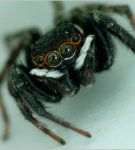 A black spider weaves a beautiful web in the shape of a trumpet
A black spider weaves a beautiful web in the shape of a trumpet 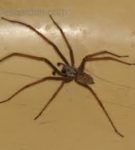 The hobo spider does not spin a web, but rather ambushes its prey.
The hobo spider does not spin a web, but rather ambushes its prey.  Jumping spider feeding on leaves
Jumping spider feeding on leaves
Each type has its own characteristics.
- Haymakers can be found near windows or in dry, warm places: closets, bedrooms. They weave a huge web and hang upside down in it, waiting for an insect.
- The size of a gray or black house spider does not exceed 2 cm. They are found on window frames, near light bulbs, and on walls.
- Vagabonds don't weave webs, they are always on the move. They quickly attack their prey, inject poison, eat it, and run to a new place for the next hunt.
- Jumper - a jumping spider with a pattern on its body. It does not eat insects, but prefers to eat acacia leaves, which is why it is most often found in the country.
The first spiders appeared on earth about 400 million years ago. Today, there are more than 40 thousand species of these animals all over the world.
How do spiders get into our houses and apartments? We ourselves carry them on our clothes or they sneak into our homes through cracks. They live especially well where there are a lot of insects. If spiders do not find food for themselves, then they will have no reason to become our neighbors.
If you are bitten house spider, don't be afraid. The only thing that can happen is burning and redness of the skin. Treat the bite site with any alcohol solution or peroxide and everything will go away.
Is it possible to get rid of such neighbors forever?
If unwanted guests have moved into your apartment and are not allowing you access at all, you should think about how to avoid the unpleasant “neighborhood”. Residents of apartment buildings will have to work together to remove spiders, since they easily move from one room to another.
The best way out in such a situation is to call professionals who will carry out pest control and get rid of the problem. During sanitization, you will be asked to leave the premises, taking your pets with you.

Professional pest control helps you quickly get rid of all the insects that have infested your apartment.
Please note that all products used are chemicals, so take the following steps:
- remove all products;
- move the furniture;
- After the specialists leave, do a wet treatment and ventilate the room well to avoid poisoning.
One-time disinfestation is not a panacea. Eat high probability that the spiders will return again after some time. In addition, keep in mind that spiders are not insects, so some products may not work on them at all.
How to remove spiders yourself in an apartment or private house
If you want to get rid of spiders on your own, first find out why you got them. If the cause is small insects, get rid of them. Seal all cracks and crevices to prevent unwanted guests from getting into your home again. In addition, take the following measures:
- go through all the corners and places where cobwebs accumulate with a broom or vacuum cleaner;
- glue the fallen wallpaper;
- Hang mosquito nets with small holes on windows and ventilation grilles.
Another tip for residents of a dacha or private home: turn off the lights outside. Midges, moths and other small insects flock to it, attracting spiders.
Fighting with chemicals
The most common means of control is “Dobrokhim FOS”, made on the basis of the active substances chlorperifos and fenthion. The insecticide is effective against ticks and all types of insects. For spiders it also represents real threat. The chemical disrupts the passage of nerve impulses, causing convulsions, paralysis and, as a result, rapid death.
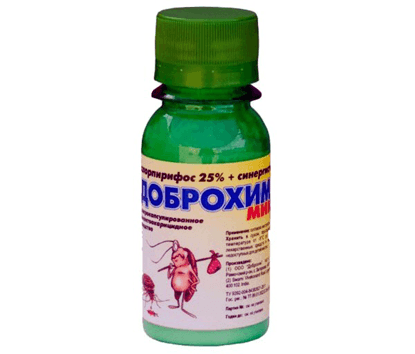
Dobrokhim FOS - good remedy to get rid of spiders in an apartment or private house
Instructions for use.
- Dilute the product at the rate of 10 ml per 1 liter of water.
- Remove children and animals from the premises.
- Spray the solution in the spiders' habitats, trying to get on them.
- After treatment, leave the apartment and leave the windows open.
- Upon return (no earlier than 24 hours later), do a wet cleaning.
The duration of the drug is 1–1.5 months.
Another proven product is Butox 50. It has a wide spectrum of insecticidal and acaricidal effects. Once in the spider's body, it causes paralysis and then lethargy with a fatal outcome.

Butox 50 - a powerful poisonous agent for fighting spiders
Method of use of the drug.
- Dilute 30 ml of product in 10 liters of water.
- Spray areas where spiders gather.
- After 20 minutes, ventilate the room and carry out wet cleaning. If necessary, repeat the treatment.
The duration of the drug is 2 months.
When working with chemicals, be sure to wear protective clothing, a mask and gloves, and wash your face and hands with soap after finishing the treatment.
Getting rid of spiders using folk remedies
You can try to kill spiders using harmless home methods. They do not like strong odors: citrus, horse chestnut, hazelnut. Grind the fruits and place them in places where spiders gather.
Spiders also cannot tolerate the smell of essential oils, such as mint and eucalyptus. To repel, use a mixture of oil and water:
- pour a little water into the sprayer for watering flowers;
- add 15 drops of essential oil;
- Treat all areas where spiders live with the resulting liquid.
You can dip pieces of cotton wool in oil, put them on a plate and place them where the spiders live. For complete removal, change scented repellers every 2 weeks.
Apply fir oil to cotton pads and scatter in the corners. The whole room will smell of pine needles and the spiders will run away.
Sirob
An unusual folk remedy is sheep's wool. According to reviews, spiders are afraid of its smell.
Spiders are very afraid of any sheep wool, be it a thread from a sweater or a scrap of wool itself. It might work, try it.
Kate
http://www.woman.ru/home/medley9/thread/3834411/2/
Vinegar is also effective in killing spiders.
- Mix 9% vinegar with water in a 1:1 ratio.
- Pour the liquid into a spray bottle.
- Spray spiders and the places where they have settled.
Instead of vinegar, you can use lemon juice.
Folk repellents - gallery
 Spiders don't like the smell of citrus fruits, such as oranges.
Spiders don't like the smell of citrus fruits, such as oranges.  Essential oils repel spiders with a strong odor
Essential oils repel spiders with a strong odor  Table vinegar is a good way to fight spiders
Table vinegar is a good way to fight spiders  Lemon juice, diluted with water, will force spiders to leave their favorite home
Lemon juice, diluted with water, will force spiders to leave their favorite home
It should be noted that folk remedies they act against spiders for a short time. Once the pungent odor dissipates, they may return.
We try insecticides, steam and ultrasound
Modern industry is inventing new means of combating insects and spiders. Sprays take first place in this series. The most famous of them is Reid. Just spray the spider from a spray can from a distance of 20–30 cm. The product acts on a residual basis for about four weeks.
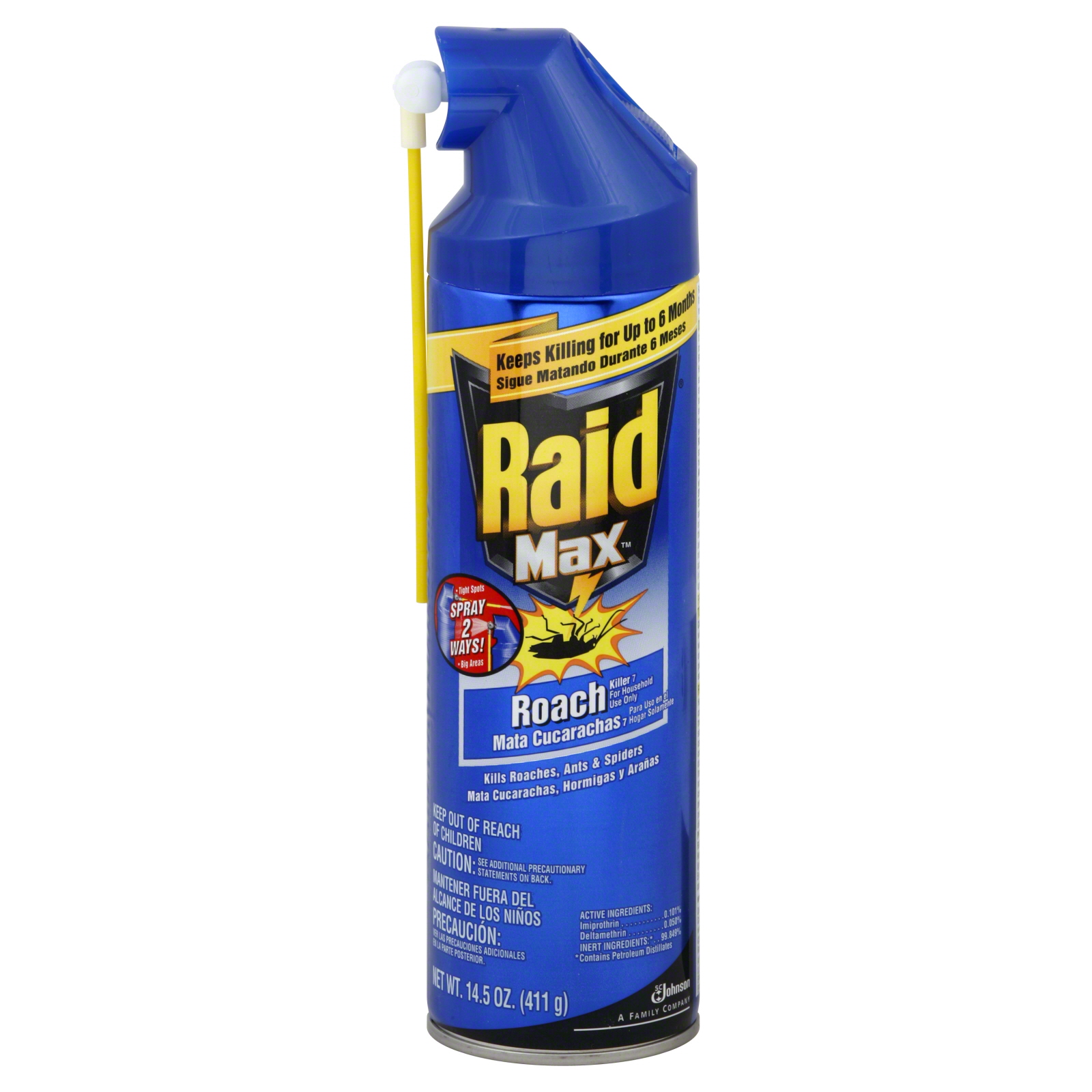
Raid - an effective spray against all types of insects and spiders
When using sprays, take precautions:
- use the product only indoors, after removing people and animals from it;
- put on gloves and a respirator;
- After finishing processing, leave the room;
- upon completion of work, wash your hands with soap and water;
- Remove any clothing that has come into contact with the spray and wash it immediately.
People, hurray! I found a remedy. Spray Raid against crawling insects (beetles, spiders, ticks, etc.) Sold in gardening departments. Jar purple. I sprayed all the corners and windows in the dacha, they writhe from it, fall and run away.
Guest
http://www.woman.ru/home/medley9/thread/3834411/2/
Another popular modern remedy is aquafumigators. They are effective against all types of insects, including spiders. The most famous of them is Raptor. When this product comes into contact with water, a thermal reaction occurs, vapors of the active substance are formed, which begin to penetrate everywhere, even into hard-to-reach places, and destroy all unwanted residents.

Aquafumigators fight insects and spiders using toxic steam
Directions for use:
- place the aquafumigator in a plastic container with water;
- leave the room for 2–3 hours;
- If necessary, re-treat after 2-3 weeks.
Ultrasonic repellers are the least effective in fighting spiders. According to studies and reviews, in most cases they are simply useless.




